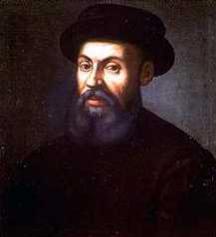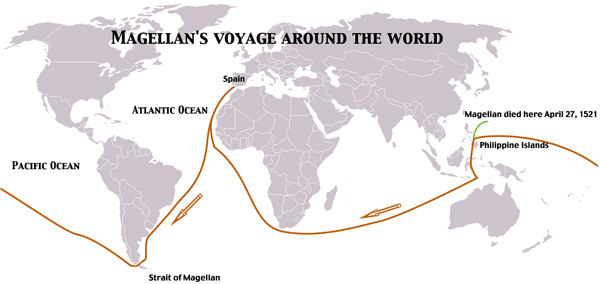 |
usa | world | animals | vocabulary | health | science | math | history |
Ferdinand Magellan
Ferdinand Magellan (Spring 1480 – April 27, 1521) was a Portuguese sea explorer who sailed for Spain. He was the first to sail from Europe westwards to Asia, the first European to sail the Pacific Ocean, and the first to lead an expedition for the purpose of circumnavigating the globe. Though Magellan himself died in the Philippines and never returned to Europe, 18 members of the crew and one ship of the fleet returned to Spain in 1522, having circumnavigated the globe.
Magellan reached Seville, the main port of Spain, on October 20, 1517, and from there went to Valladolid to see the teenaged king, Charles I (later Holy Roman Emperor Charles V).
With the help of Juan de Aranda, one of the three chief officials of Seville's India House, and of other friends, especially Diogo Barbosa, a Portuguese, Magellan became naturalized as a Spaniard. Acquiring great influence in Seville, he gained the ear of Charles and the powerful Juan Rodriguez de Fonseca, bishop of Burgos and the persistent enemy of Christopher Columbus.
Having brought the Portuguese cartographical knowledge to the Spanish court, Magellan pointed out that there would exist a passage from South America, which he thought to be the Rio de la Plata, to the Pacific Ocean, forming a large bay-like river delta. He decided to pioneer this route to reach the Moluccas (Spice Islands), the key to the strategic and tremendously lucrative spice trade. He allegedly declared himself ready to sail southwards to 75° to realize his project.

Ferdinand Magellan
Ruy Faleiro, an astronomer and Portuguese exile, aided him in his plan, and he found an invaluable financial ally in Christopher de Haro, a member of a great Antwerp firm who had a grudge against the king of Portugal. On March 22, 1518, King Charles approved Magellan's plan and granted him generous funds. Under the contract, Magellan and Faleiro, as joint captains-general, would receive one-twentieth of all profits and they and their heirs would gain the government of any lands discovered, with the title of Adelantados.
Magellan took an oath of allegiance in the church of Santa María de la Victoria de Triana, giving money to the monks of the monastery so they would pray for his success.
With the money that Magellan and Faleiro had received from the king, the pair obtained five ships: the Trinidad (tonnage 110, crew 55), the San Antonio (tonnage 120, crew 60), the Concepcion (tonnage 90, crew 45), the Victoria (tonnage 85, crew 42), and the Santiago (tonnage 75, crew 32). The Trinidad was Magellan's flagship, and besides Faleiro the captains for the other four were Juan de Cartegena, Gomez, Gaspar de Quesada and Luis de Mendoza, respectively.
On August 10, 1519, the fleet of five ships under Magellan's command left Seville and traveled south from the Guadalquivir River to San Lucar de Barrameda at the mouth of the rivers, where they remained more than five weeks. Spanish authorities were wary of the Portuguese admiral and almost prevented Magellan from sailing, but on September 20, Magellan set sail from Sanlúcar de Barrameda with 270 men.
Upon hearing of his departure, King Manuel ordered a naval detachment to pursue him, but Magellan eluded the Portuguese. After a brief stop at the Canary Islands, Magellan arrived at the Cape Verde Islands, where they set course for Cape St. Augustine in Brazil. On November 20, the equator was crossed; on December 6, the crew sighted Brazil.
Since Brazil was Portuguese territory at the time, Magellan avoided it, and on December 13 anchored near present-day Rio de Janeiro, where the weather and the natives were generally friendly. There the fleet was resupplied, but these good conditions caused them to delay. Afterwards, they continued to sail south along South America's east coast, looking for the strait that Magellan believed would lead to the Spice Islands. The fleet reached Río de la Plata on January 10, 1520. It was already late in the season, however, and the southern winter struck while they were still on the Argentinian coast.

Magellan decided to spend the winter in Patagonia. On March 31, the crew established a settlement that they called Puerto San Julian. A mutiny involving three of the five ship captains broke out. It was unsuccessful, mainly because the crew remained loyal. Quesada and Mendoza were executed, and Cartagena and a priest were marooned on the coast.
On August 24, the journey resumed. Magellan, behind schedule, was impatient to make up for lost time, and set out again while the weather still posed problems. The Santiago, sent down the coast on a scouting expedition, was wrecked in a sudden storm. All of its crewmembers survived and made it safely to shore. Two of them returned, overland, to inform Magellan of what had happened, and bring rescue to their comrades. After this experience, Magellan decided to wait for a few weeks more before again resuming the voyage.
At 52° South latitude on October 21, 1520, the fleet reached Cape Virgenes and concluded they had found the passage, because the waters were brine and deep inland. Four ships began an arduous passage through the 373-mile long passage that Magellan called the Estreito (Canal) de Todos los Santos, or "All Saints' Channel," because All Saint's Day, November 1, occurred while the fleet traveled through it. Now, the strait is named the Strait of Magellan.
Magellan first assigned Concepcion and San Antonio to explore the strait, but the latter, commanded by Gomez, deserted and returned to Spain. On November 28, the three remaining ships entered the South Pacific. Magellan named the waters the Mar Pacifico (Pacific Ocean) because of its apparent stillness.
Heading northwest, the crew reached the equator on February 13, 1521. On March 6, they reached the Marianas and on March 16, the island of Homonhon in the Philippines, with 150 crewmen left. Magellan was able to communicate with the native peoples because his Malay interpreter could understand their language. They traded gifts with Rajah Kolambu of Limasawa, who guided them to Cebu, on April 7. Rajah Humabon of Cebu was friendly to them, and even agreed to accept Christianity. Magellan died in the Philippines on April 27 in the Battle of Mactan against indigenous forces led by Lapu-Lapu.
One of Magellan's ships circumnavigated the globe, finishing 16 months after the explorer's death.Magellan had provided in his will that his Malay interpreter was to be freed upon his death. His interpreter, who was baptized Enrique (Henry) in Malacca 1511, had been captured by Sumatran slavers from his home islands. Thus Enrique became the first man to circumnavigate the globe (in multiple voyages). Enrique was indentured by Magellan during his earlier voyages to Malacca, and was at his side during the battles in Africa, during Magellan's disgrace at the King's court in Portugal, and during Magellan's successful raising of a fleet. However, after Mactan, the remaining ship's masters refused to free Enrique. Enrique escaped his indenture on May 1, with the aid of Rajah Humabon, amid the deaths of almost 30 crewmen. However, Antonio Pigafetta had been making notes about the language, and was apparently able to continue communications during the rest of the voyage.
The casualties suffered in the Philippines left the expedition with too few men to sail the three remaining ships. Accordingly, on May 2, 1521, they abandoned Concepcion, burning the ship to make sure it could not be used against them. The fleet, now reduced to Trinidad and Victoria, fled westward to Palawan. They left that island on June 21, 1521, and were guided to Brunei, Borneo by Moro pilots, who could navigate the shallow seas. They anchored off the Brunei breakwater for 35 days, where the Venetian Pigafetta mentions the splendor of Rajah Siripada's court (gold, two pearls the size of hens' eggs, etc.). In addition, Brunei boasted tame elephants and armament of 62 cannon, more than 5 times the armament of Magellan's ships. Brunei disdained the cloves which were to prove more valuable than gold, upon the return to Spain. Pigafetta mentions some of the technology of the court, such as porcelain (which was not yet widely available in Europe), and spectacles (eye-glasses were only just becoming available in Europe).
After reaching the Moluccas (the Spice Islands) November 6, 1521, 115 crew were left. They managed to trade with the Sultan of Tidore, a rival of the Sultan of Ternate, who was the ally of the Portuguese.
The two remaining ships, laden with valuable spices, attempted to return to Spain by sailing west. As they left the Moluccas, however, the Trinidad was found to be taking on water. The crew tried to discover and repair the leak, but failed. They concluded that the Trinidad would need to spend considerable time being overhauled. The small Victoria was not large enough to accommodate all the surviving crewmembers. As a result, the Victoria with some of the crew sailed west for Spain. Several weeks later, the Trinidad left the Moluccas to attempt to return to Spain via the Pacific route. This attempt failed; the ship was captured by the Portuguese, and was eventually wrecked in a storm while at anchor under Portuguese control.
The Victoria set sail via the Indian Ocean route home on December 21, 1521. By May 6, 1522, the Victoria, commanded by Juan Sebastián Elcano, rounded the Cape of Good Hope, with only rice for rations. Twenty crewmen died of starvation before Elcano put in to the Cape Verde Islands, a Portuguese holding, where he abandoned 13 more crewmen July 9 in fear of losing his cargo of 26 tons of spices (cloves and cinnamon).
On September 6, 1522, Juan Sebastián de Elcano and the remaining crew of Magellan's voyage and the last ship of the fleet, Victoria, arrived in Spain, almost exactly three years after leaving. The expedition actually eked out a small profit, but the crew were not paid their full wages
This article is licensed under the GNU Free Documentation License. It uses material from the Wikipedia article "Magellan".